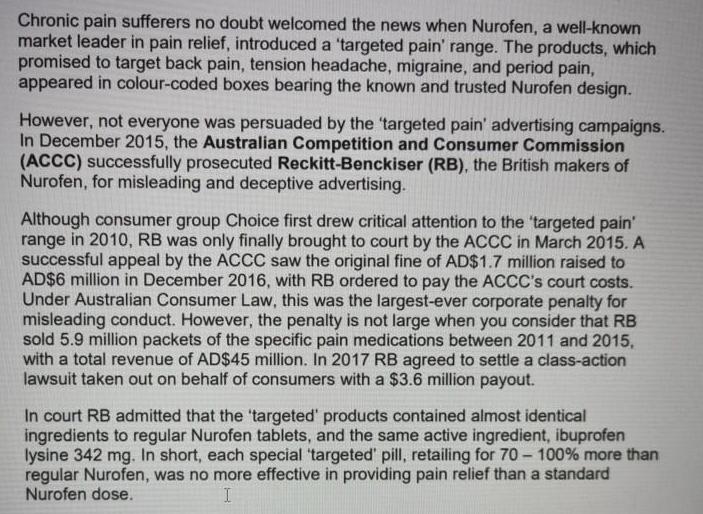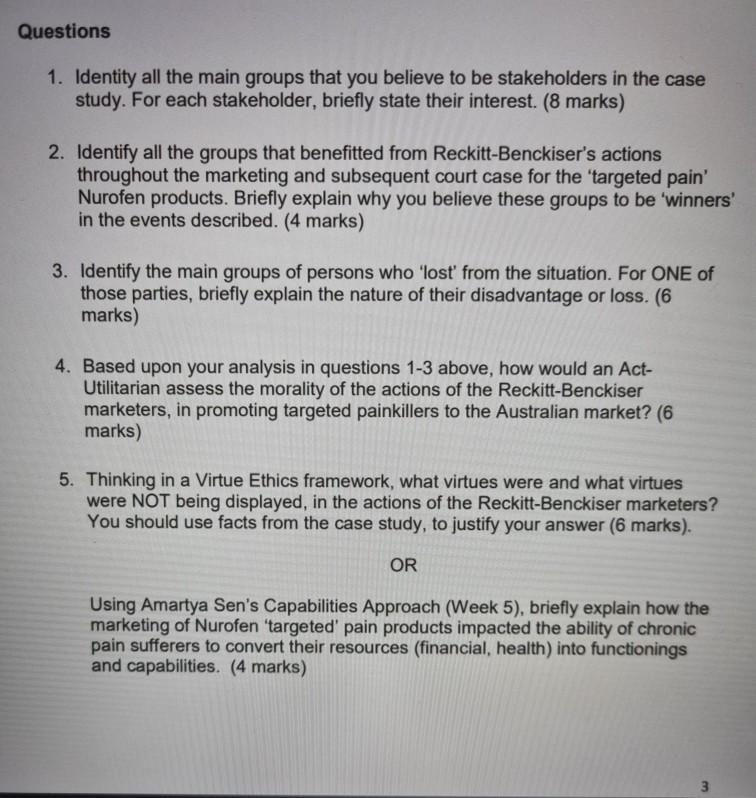Answered step by step
Verified Expert Solution
Question
1 Approved Answer
Chronic pain sufferers no doubt welcomed the news when Nurofen, a well-known market leader in pain relief, introduced a 'targeted pain' range. The products,



Chronic pain sufferers no doubt welcomed the news when Nurofen, a well-known market leader in pain relief, introduced a 'targeted pain' range. The products, which promised to target back pain, tension headache, migraine, and period pain, appeared in colour-coded boxes bearing the known and trusted Nurofen design. However, not everyone was persuaded by the 'targeted pain' advertising campaigns. In December 2015, the Australian Competition and Consumer Commission (ACCC) successfully prosecuted Reckitt-Benckiser (RB), the British makers of Nurofen, for misleading and deceptive advertising. Although consumer group Choice first drew critical attention to the 'targeted pain' range in 2010, RB was only finally brought to court by the ACCC in March 2015. A successful appeal by the ACCC saw the original fine of AD$1.7 million raised to AD$6 million in December 2016, with RB ordered to pay the ACCC's court costs. Under Australian Consumer Law, this was the largest-ever corporate penalty for misleading conduct. However, the penalty is not large when you consider that RB sold 5.9 million packets of the specific pain medications between 2011 and 2015, with a total revenue of AD$45 million. In 2017 RB agreed to settle a class-action lawsuit taken out on behalf of consumers with a $3.6 million payout. In court RB admitted that the 'targeted' products contained almost identical ingredients to regular Nurofen tablets, and the same active ingredient, ibuprofen lysine 342 mg. In short, each special 'targeted' pill, retailing for 70 - 100% more than regular Nurofen, was no more effective in providing pain relief than a standard Nurofen dose. Who were the victims? According to Hallam (2015), the very features that led the ACCC to prosecute RB in the Australian courts - false and misleading product claims; overpricing to confirm the 'special' nature of an ordinary product might enhance the perceived effectiveness of some drugs. There is a widespread assumption that "good drugs cost more". Thus, in the eyes of some consumers, paying more for some drugs is not price gouging, but a confirmation that a medication will work. Furthermore, where there is no known cure, some medical professionals favour prescribing placebo drugs, with or without the patient's knowledge. Surely Nurofen was doing over the counter what doctors do in the surgery? Suzanne Moore (2015) suggests that consumers buying targeted Nurofen products were being self-indulgent, paying a premium for the psychological comfort of little magic bullets that "not only stop our pain, but also feel it and understand it". Undoubtedly, some harms were done, and to a range of vulnerable consumers. The following groups were most likely to be taken in by the 'targeted pain' marketing claims: persons of reduced intellectual capacity, persons of limited education, and chronic pain sufferers. These social groups typically present as low income, unemployed or under-employed, and often living on income support. If so, then RB's victims were those members of society who can least afford to waste their resources chasing a placebo effect. The ACCC argued in court that the 'targeted pain' products, and the Nurofen website were 'inherently misleading'. RB marketers were encouraging customers to stock their medicine cabinets with multiple coloured boxes of the same basic Nurofen product, in the pursuit of adequate pain relief. With the targeted products retailing for at least 170% of the price of a normal box of Nurofen, a chronic pain sufferer seeking relief, could stock up to four boxes where once they stocked a single box of Nurofen, raising their Nurofen spend six-fold, to at least 580% (and possibly 680%, for anyone continuing to purchase regular Nurofen alongside the specific pain products). And the inevitable wastage as consumers discarded expired pain medications, would rise across multiple box purchases, adding to natural resource wastage and environmental pollution. Those Nurofen customers lacking the desire, capacity or time to read labels carefully could be deceived into overdosing on Nurofen, as they took doses they mistakenly believed to be 'targeting' multiple pain symptoms. Questions 1. Identity all the main groups that you believe to be stakeholders in the case study. For each stakeholder, briefly state their interest. (8 marks) 2. Identify all the groups that benefitted from Reckitt-Benckiser's actions throughout the marketing and subsequent court case for the 'targeted pain' Nurofen products. Briefly explain why you believe these groups to be 'winners' in the events described. (4 marks) 3. Identify the main groups of persons who 'lost' from the situation. For ONE of those parties, briefly explain the nature of their disadvantage or loss. (6 marks) 4. Based upon your analysis in questions 1-3 above, how would an Act- Utilitarian assess the morality of the actions of the Reckitt-Benckiser marketers, in promoting targeted painkillers to the Australian market? (6 marks) 5. Thinking in a Virtue Ethics framework, what virtues were and what virtues were NOT being displayed, in the actions of the Reckitt-Benckiser marketers? You should use facts from the case study, to justify your answer (6 marks). OR Using Amartya Sen's Capabilities Approach (Week 5), briefly explain how the marketing of Nurofen 'targeted' pain products impacted the ability of chronic pain sufferers to convert their resources (financial, health) into functionings and capabilities. (4 marks)
Step by Step Solution
★★★★★
3.38 Rating (154 Votes )
There are 3 Steps involved in it
Step: 1
1 Stakeholders a Patients The patients who receive the treatment is one of the most important stakeholder they are interested because they need relive ...
Get Instant Access to Expert-Tailored Solutions
See step-by-step solutions with expert insights and AI powered tools for academic success
Step: 2

Step: 3

Ace Your Homework with AI
Get the answers you need in no time with our AI-driven, step-by-step assistance
Get Started


